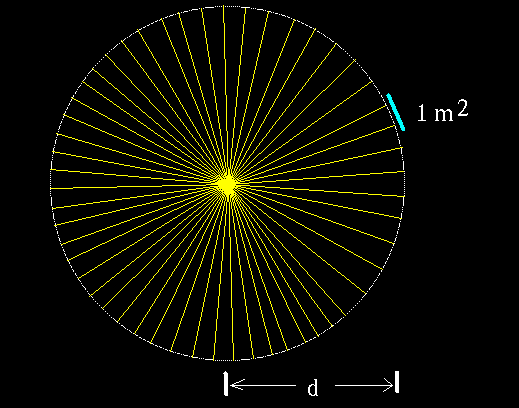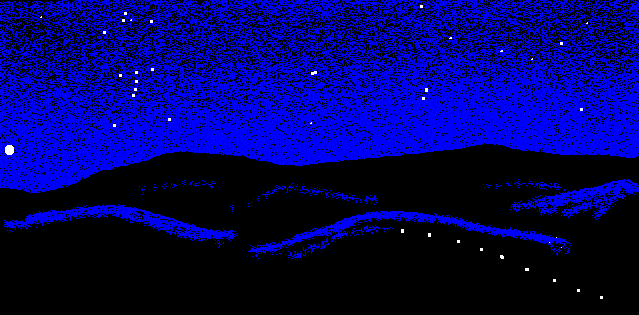Luminosity and how far away things are
In this class, we will describe how bright a star or galaxy really
is by its luminosity.
The luminosity is how much energy is coming from the per second. The
units are watts (W).
Astronomers often use another measure, absolute magnitude.
Absolute magnitude is based on a ratio scale, like apparent
magnitued. I think it is confusing.
The luminosity of the Sun is
Lsun = 3.9 x 1026 W
We will often measure luminosities of stars in units of the
luminosity. That is, we might say for a certain star
Lstar = 5.2 x Lsun, meaning that the
star has 5.2 times the energy output per second of the Sun.
Apparent brightness
In this class, we will describe how bright a star seems as seen
from Earth by its apparent brightness. This is often
called the intensity of the starlight. Sometimes it
is called the flux of light.
The apparent brightness is how much energy is coming from the
star per square meter per second, as measured on Earth. The
units are watts per square meter (W/m2).
Astronomers usually use another measure, magnitude. (Our
book calls it apparent magnitude.) Since magnitude is so
commonly used, we need to understand a little about it too. The
magnitude system stems from ancient Greece. A very bright star was
called ``first magnitude,'' a pretty bright star is ``second
magnitude,''... a barely visible star is ``sixth magnitude.''
Measuring luminosity
Since we can't go to a star to measure its luminosity, we have
to be clever. If we know the distance to the star
we can do it, because there is a simple relation between
- the distance d to the star,
- the apparent brightness b of the star, and
- the luminosity L of the star.
The relation is

This relation is based on conservation of energy. Consider
an observer a distance d from the star. How much
energy crosses a square meter detector that this observer has?
- All of the energy produced by the star per second must cross
a sphere of radius d.
- The study of geometry tells us that area of this sphere is 4 Pi d2.
- a 1 m2 detector gets a fraction
(1 m2)/(total area)
of this.

Note that the brightness decreases proportionally to the square of the
distance as one moves away from the star. This can be demonstrated
experimentally in the laboratory.
We can write the relation so that it gives L in terms
of b and d.
- It is easy to measure the apparent
brightness b (e.g. with a telescope and a CCD).
- It is not so easy to measure the distance, but we have already
seen something about how that can be done.
- Putting these toghther, we get L.
Luminosities of stars
One finds
- There are a few stars that are more luminous than the Sun.
- For instance, Betelgeuse has L ~ 14000 x Lsun.
- Most stars are less luminous than the Sun.
- For instance, Lstar ~ 0.001 x Lsun
is not unusual.
- There are lots more low luminosity stars than high luminosity
stars.
Using brightness and luminosity to get distance
- It is easy to measure the apparent brightness of a star, a galaxy,
a supernova, ...
- If somehow we know the luminosity of such an object, then
we can compute its distance from us.

- This is the essence of how we learn the distances to things.
- Example: You have a 100 W lightbulb in your laboratory. Standing a
distance d from the lightbulb, you measure apparent brightness of the lightbulb to be 0.1
W/m2. How can you use this information to determine the
distance from you to the lightbulb? (An approximate answer is OK. In particular, you can approximate 4 Pi = 12.566 by 10.)

- The luminosity of the lightbulb is L = 100 W.
- The brightness is b = 0.1 W/m2.
- So the distance is given by d2 = (100 W)/(4 Pi x 0.1 W/m2).
- Since 4 Pi is approximately 10, this is d2 = (100 / 1) m2.
- Thus d2 = 100 m2.
- We now know what d2 is. We want to know what d is. So
we take the square root.
- So d = 10 m.
- Example: You see a 1000 W streetlamp on a distant hill. You measure the
apparent brightness of the streetlamp to be 0.000001
W/m2. How can you use this information to determine the
distance to the hill? (An approximate answer is OK. In particular, you can approximate 4 Pi = 12.566 by 10.))

- The luminosity of the streetlamp is L = 1000 W = 103 W.
- The brightness is b = 0.000001 W/m2 = 10-6 =
W/m2.
- So the distance is given by d2 = (103 W)/(4 Pi x 10-6 W/m2).
- Since 4 Pi is approximately 10, this is d2 = (103 /(10 x 10-6)) m2.
- Thus d2 = (103 / 10-5) m2.
- So d2 = 108 m2
- We now know what d2 is. We want to know what d is. So
we take the square root.
- So d = 104 m = 10 km.
Davison E. Soper, Institute of Theoretical Science,
University of Oregon, Eugene OR 97403 USA
soper@bovine.uoregon.edu





